Bios 256 week 4 Study guides, Class notes & Summaries
Looking for the best study guides, study notes and summaries about Bios 256 week 4? On this page you'll find 73 study documents about Bios 256 week 4.
Page 3 out of 73 results
Sort by
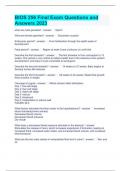
-
BIOS 256 Final Exam Questions and Answers 2023
- Exam (elaborations) • 8 pages • 2023
-
Available in package deal
-
- $17.99
- + learn more
BIOS 256 Final Exam Questions and Answers 2023 what are male gametes? Sperm What are female gametes? Secondary oocytes Embryonic period? From fertilization through the eighth week of development Fetal period? Begins at week 9 and continues on until birth Describe the first trimester? The first trimester is from conception to 13 weeks. This period is very critical to babies health due to the extensive oran-system development, and baby is most vulnerable to terato...
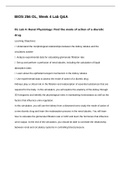
-
BIOS 256 OL, Week 4 Lab Q&A
- Exam (elaborations) • 5 pages • 2022
-
Available in package deal
-
- $7.99
- + learn more
BIOS 256 OL, Week 4 Lab Q&A OL Lab 4: Renal Physiology: Find the mode of action of a diuretic drug Learning Objectives: • Understand the morphological relationships between the kidney tubules and the circulatory system • Analyze experimental data for calculating glomerular filtration rate • Set up and perform a perfusion of renal tubules, including the calculation of liquid absorption rates • Learn about the epithelial transport mechanism in the kidney tubules • Use experime...
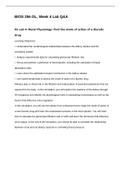
-
BIOS 256 OL, Week 4 Lab Q&A
- Exam (elaborations) • 5 pages • 2023
-
- $13.99
- + learn more
BIOS 256 OL, Week 4 Lab Q&A. OL Lab 4: Renal Physiology: Find the mode of action of a diuretic drug Learning Objectives: • Understand the morphological relationships between the kidney tubules and the circulatory system • Analyze experimental data for calculating glomerular filtration rate • Set up and perform a perfusion of renal tubules, including the calculation of liquid absorption rates • Learn about the epithelial transport mechanism in the kidney tubules • Use experimen...
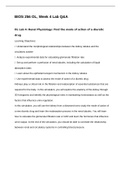
-
BIOS 256 OL, Week 4 Lab Q&A
- Exam (elaborations) • 5 pages • 2023
-
- $13.99
- + learn more
BIOS 256 OL, Week 4 Lab Q&A. OL Lab 4: Renal Physiology: Find the mode of action of a diuretic drug Learning Objectives: • Understand the morphological relationships between the kidney tubules and the circulatory system • Analyze experimental data for calculating glomerular filtration rate • Set up and perform a perfusion of renal tubules, including the calculation of liquid absorption rates • Learn about the epithelial transport mechanism in the kidney tubules • Use experimen...

-
BIOS 256 AP 4 Exam Elaborations (highly rated)
- Exam (elaborations) • 35 pages • 2023
-
- $10.89
- + learn more
Week 2: Chapter 24: The Digestive System part two Basic GI Functions Primary function: movement of nutrient molecules from the external environment to the internal environment. (Absorption of nutrients) Food->Digestion->motility and absorption Pancreas Gland in the retroperitoneal space behind the stomach Produces enzymesthat digest carbs, proteins, fats, and nucleic acids Produces the sodium bicarbonate buffer Emptiesthe contents into duodenum Relationship of the Pancreas to th...

-
BIOS 256 Week 4 Discussion; Glomerular Filtration
- Other • 3 pages • 2022
- Available in package deal
-
- $12.49
- + learn more
What is Glomerular Filtration? How is the Glomerular Filtration Rate (GFR) determined? What regulatory mechanisms help control and stabilize GFR?

-
BIOS 256 (A&P 4) WEEK 6 QUIZ.
- Exam (elaborations) • 4 pages • 2024
-
- $18.49
- + learn more
Feel free to add any questions you remember 1. The type of protein in contractile muscles a. Fibrous protein b. Globular protein c. Steroidal d. ? 2. What is the average O2 in the body a. 12.0 mL/100mL b. 18.2 mL/100 mL c. 448 mL/ 100 mL d. 25.2 mL/100 mL 3. What is NOT a necessary function of survival? a. Reproduction b. Movement c. Maintenance of barriers d. Decay e. Etc 4. Definition of mRNA 5. Labeling diagrams a. Peripheral proteins b. Glycolipid c. Main lysosome d. Sm...
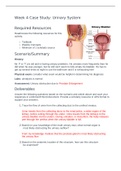
-
BIOS 256 Week 4 Case Study; Urinary System
- Other • 2 pages • 2022
- Available in package deal
-
- $20.49
- + learn more
Required Resources Read/review the following resources for this activity: • Textbook • WeeklyConcepts • Minimum of 1 scholarlysource Scenario/Summary History: Mr. P is 77 yrs old and is having urinary problems. He urinates more frequently than he did when he was younger, but he still can't seem to fully empty his bladder. He has to get up several times at night to use the bathroom and it is exhausting him! Physical exam: consider what exam would be helpful in determining his d...
BIOS 256 Week 4 Lab: Urinary System Part A: Lab Manual Exercises 36 Show Less
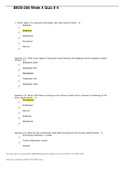
-
BIOS-256 Week 4 Quiz # 4 (GRADED A) Questions and Answer elaborations | Chamberlain College of Nursing
- Exam (elaborations) • 5 pages • 2022
-
Available in package deal
-
- $10.99
- + learn more
BIOS-256 Week 4 Quiz # 4 Question.Which region of a long bone articulates with other bones? (Points : 3) Question. What is the region of long bone found between the diaphysis and the epiphysis calle d? (Points : 3) Question. What is the fibrous covering on the surface of bone that is involved in thickening of the bone called? (Points : 3) Question. What are the extracellular fluid-filled extensions of the lacunae called? (Points : 3) Question. How are osteons in compact bone tissue aligned? (Poi...

Did you know that on average a seller on Stuvia earns $82 per month selling study resources? Hmm, hint, hint. Discover all about earning on Stuvia



